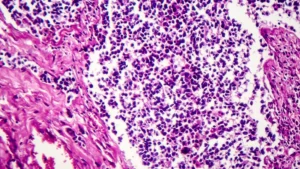Medications for Non-Small Cell Lung Cancer
Introduction: Non-small cell lung cancer (NSCLC) is one of the most common types of lung cancer. In recent years, there have been significant advancements in the development of medications to treat NSCLC. These medications are designed to target specific aspects of the cancer cells and halt their growth. This article will provide an overview of the different types of medications used for NSCLC and their goals.

Goal of Medications
The main goal of medications for non-small cell lung cancer is to effectively treat the disease by inhibiting the growth and spread of cancer cells. These medications aim to improve the overall survival rate of patients, alleviate symptoms, and enhance the quality of life. Depending on the stage of NSCLC and the patient’s specific condition, healthcare professionals determine the most appropriate medications and treatment plan. Medications can be administered alone or in combination with other therapies to maximize their effectiveness.
Chemotherapy
Chemotherapy is a widely used treatment for non-small cell lung cancer. It involves the use of powerful medications that kill or suppress cancer cells, shrinking tumors and preventing them from spreading. Chemotherapy drugs are usually administered intravenously or orally. They can affect both cancerous and healthy cells, leading to side effects such as fatigue, hair loss, nausea, and reduced immune function. However, new chemotherapy drugs are being developed with reduced side effects and increased efficacy.
Immunotherapy
Immunotherapy has revolutionized the treatment of non-small cell lung cancer. This approach harnesses the body’s immune system to fight cancer cells. Immunotherapy medications, such as immune checkpoint inhibitors, block certain proteins on cancer cells, enabling the immune system to recognize and attack them. This treatment has shown significant success in prolonging survival rates and improving overall outcomes for NSCLC patients. Common side effects of immunotherapy include fatigue, skin rash, diarrhea, and other immune-related reactions.
Targeted Therapy
Targeted therapy focuses on specific abnormalities within cancer cells that allow them to grow and survive. These medications inhibit the action of these abnormalities, preventing the cancer cells from multiplying. Targeted therapy is an effective treatment for NSCLC patients with genetic mutations, such as EGFR or ALK gene mutations. These mutations drive the growth of cancer cells, and by targeting them, the medications can block their effects. Targeted therapy often has fewer side effects compared to traditional chemotherapy.
Other Treatments
In addition to chemotherapy, immunotherapy, and targeted therapy, there are other treatment options for non-small cell lung cancer. These include radiation therapy, photodynamic therapy, and surgery. Radiation therapy uses high-energy X-rays to kill cancer cells, either externally or internally. Photodynamic therapy involves the use of a photosensitizing agent and a specific type of light to destroy cancer cells. Surgery aims to remove the tumor and surrounding tissues. The choice of treatment depends on the stage and location of the cancer, as well as the individual patient’s situation.
Outlook
The outlook for non-small cell lung cancer patients has improved significantly in recent years due to advancements in medication and treatment options. Many patients now have access to personalized treatment plans that consider their specific genetic mutations and overall health. Research is ongoing, and new medications and therapies continue to be developed to further enhance outcomes for NSCLC patients. Early detection, combined with prompt and appropriate treatment, offers the best chances of a positive prognosis and increased survival rates.
Summary
Medications for non-small cell lung cancer have come a long way in recent years, offering patients more hope and improved outcomes. Chemotherapy, immunotherapy, and targeted therapy are among the most commonly used medication approaches. These treatments aim to inhibit cancer cell growth, improve survival rates, and enhance the overall quality of life for NSCLC patients. Additional treatments such as radiation therapy, photodynamic therapy, and surgery may also be utilized depending on the specific situation. With ongoing research and advancements in personalized medicine, the future is promising for those battling non-small cell lung cancer.
Conclusion:
Non-small cell lung cancer is a challenging disease, but with the advancement of medications and treatment options, there is hope for better outcomes and increased survival rates. The goal of these medications is to effectively treat NSCLC by halting cancer cell growth and improving the quality of life for patients. Chemotherapy, immunotherapy, targeted therapy, and other treatments provide patients with personalized options based on their specific condition. Ongoing research and the development of new medications offer a promising outlook for those affected by non-small cell lung cancer.